Hidden Christian Sites in the Nagasaki Region
| UNESCO World Heritage Site | |
|---|---|
 Ōura Cathedral | |
| Location | Nagasaki and Kumamoto, Japan |
| Criteria | Cultural: iii |
| Reference | 1495 |
| Inscription | 2018 (42nd Session) |
| Area | 5,566.55 ha |
| Buffer zone | 12,252.52 ha |
| Coordinates | 32°44′03″N 129°52′13″E / 32.734106°N 129.870236°E |
 Location of Hidden Christian Sites in the Nagasaki Region in Japan | |
Hidden Christian Sites in the Nagasaki Region (Japanese: 長崎と天草地方の潜伏キリシタン関連遺産) is a group of twelve sites in Nagasaki Prefecture and Kumamoto Prefecture relating to the history of Christianity in Japan. The Nagasaki churches are unique in the sense that each tells a story about the revival of Christianity after a long period of official suppression.[1]
Proposed jointly in 2007 for inscription on the UNESCO World Heritage List under criteria ii, iii, iv, v, and vi, the submission named at the time Churches and Christian Sites in Nagasaki on the Tentative List, was recognized on January 30, 2018, as a World Heritage Site.
The initial nomination included 26 sites; however, after reconsideration the Nagasaki Prefecture reduced the monuments to 13 sites.[2] Twelve sites were recognized. Concerns over the Hidden Christian Sites in the Nagasaki Region have been widely discussed in the academic literature.[3]
Christianity in Japan[]
Christianity arrived in Japan in 1549 with the Jesuit missionary Francis Xavier. Fanning out from Nagasaki, the new faith won many converts, including a number of daimyōs. Toyotomi Hideyoshi then Tokugawa Ieyasu persecuted those professing to be Christian. After the Shimabara Rebellion of 1637–1638, the official suppression of Christian practices was combined with a policy of national seclusion that lasted over two centuries. With the advent of Western powers and reopening of Japan in the 1850s and the reforms of the Meiji Restoration, missionary activity was renewed and a number of Hidden Christians resurfaced. Ōura Cathedral of 1864 is the first of the churches built in subsequent years.[4]
On 30 June 2018, thanking the UNESCO for the admission in the World Heritage List, the then Prime Minister Shinzo Abe publicly declared that the Hidden Christian Sites "convey the 'shape' of a faith that is unique to Japan and they are truly unparalleled worldwide as heritage of humankind."[5]
Monuments[]
| Name | Completion Date | Location | Construction type | Comments | Image |
|---|---|---|---|---|---|
| Ōura Cathedral and Related Facilities (大浦天主堂)[6] | 1864 | Nagasaki | Brick | National Treasure | 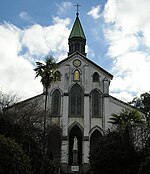
|
| Kuroshima Church (黒島天主堂)[7] | 1902 | Sasebo | Brick | Important Cultural Property | 
|
| Former Gorin Church (旧五輪教会堂)[8] | 1881 | Gotō | Wood | Important Cultural Property | 
|
| Kashiragashima Church (頭ヶ島天主堂)[9] | 1919 | Shinkamigotō | Stone | Important Cultural Property | 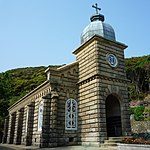
|
| Tabira Church (田平天主堂)[10] | 1917/8 | Hirado | Brick | No Entry | 
|
| Shitsu Church (出津教会) | 1882 | Nagasaki | Brick | 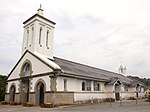
| |
| Ōno Church (大野教会堂)[11] | 1893 | Nagasaki | Stone | Important Cultural Property | 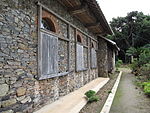
|
| Former Nokubi Church and related remains (旧野首教会) | 1908 | Ojika | Brick | 
| |
| Egami Church (江上天主堂)[12] | 1917/8 | Gotō | Wood | Important Cultural Property | 
|
| Hara Castle remains (原城跡)[13] | Minamishimabara | Historic Site | 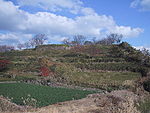
| ||
| Hinoe Castle remains (日野江城跡)[14] | Minamishimabara | Not Entry | 
| ||
| Hirado Island’s sacred places and villages (平戸島の聖地と集落) | Hirado, Nagasaki | Important Cultural Landscape | 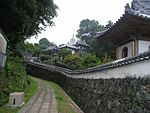
| ||
| Sakitsu Village in Amakusa (天草の﨑津集落) | Amakusa, Kumamoto | Important Cultural Landscape | 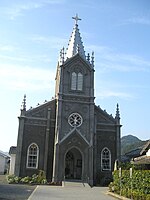
|
Previous Nominated Monuments[]
The list consists of sites previously nominated, but currently not in the list.
| Name | Completion Date | Location | Construction type | Comments | Image |
|---|---|---|---|---|---|
| Former Catholic Seminary (旧羅典神学校)[15] | 1875 | Nagasaki | Timber-framed Brick | Important Cultural Property | 
|
| Aosagaura Church (青砂ヶ浦天主堂)[16] | 1910 | Shinkamigotō | Brick | Important Cultural Property | 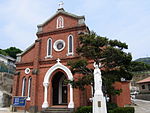
|
| Mementos of Father Marc Marie de Rotz (ド・ロ神父遺跡) | Nagasaki | ||||
| Former Shitsu Aid Center (旧出津救助院)[17][18][19] | Nagasaki | Shelter, macaroni factory, and sardine processing area are all Important Cultural Properties | 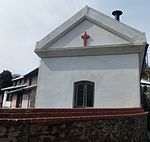
| ||
| Dōzaki Church (堂崎教会) | 1907 | Gotō | Brick | 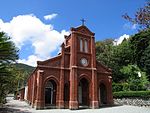
| |
| Hōki Church (宝亀教会) | 1899 | Hirado | Wood/Brick | 
| |
| Christian tombstone (吉利支丹墓碑)[20] | Minamishimabara | Historic Site | 
| ||
| Site of the Martyrdom of the 26 Saints of Japan (日本二十六聖人殉教地) | 1864 | Nagasaki | 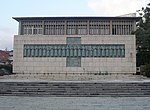
| ||
| Site of Saint Dominic Church (サント・ドミンゴ教会跡) | 1609 | Nagasaki | 
| ||
| Urakami Cathedral (浦上天主堂) | 1959 | Nagasaki | Reinforced concrete | 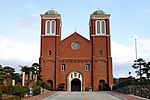
| |
| Former Residence of Archbishop (旧大司教館) | 1914 | Nagasaki | 
| ||
| Kaminoshima Church (神ノ島教会) | 1897 | Nagasaki | Brick | 
| |
| Kurosaki Church (黒崎教会) | 1920 | Nagasaki | Brick | 
| |
| Himosashi Church (紐差教会) | 1929 | Hirado | Reinforced concrete | 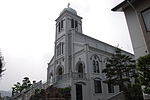
| |
| Ōso Church (大曾教会) | 1916 | Shinkamigotō | Brick |
See also[]
- Kirishitan
- Kakure Kirishitan
- Tenshō embassy
- Hasekura Tsunenaga
- Nagasaki Peace Park
- World Heritage Sites in Japan
- National Treasures of Japan
Notes[]
- ^ "Churches and Christian Sites in Nagasaki". UNESCO. Retrieved 21 Sep 2011.
- ^ "Churches and Christian Sites in Nagasaki". UNESCO.; "Outline of Churches and Christian Sites". Nagasaki Prefecture. Retrieved 29 July 2014.
- ^ http://www.drustvo-antropologov.si/AN/PDF/2017_3/Anthropological_Notebooks_XIII_3_Delakorda.pdf
- ^ Finn, Dallas (1995). Meiji Revisited: The Sites of Victorian Japan. Weatherhill. pp. 12f. ISBN 0-8348-0288-0.
- ^ "Message by Prime Minister Shinzo Abe on the Inscription of "Hidden Christian Sites in Nagasaki and the Amakusa Region" on UNESCO's World Heritage List". June 30, 2018. Retrieved August 29, 2020.
- ^ "大浦天主堂 (Ōura Cathedral) ID 3522". Database of National Cultural Properties, Agency for Cultural Affairs. Retrieved 21 Sep 2011.
- ^ "黒島天主堂 (Kuroshima Church) ID 3541". Database of National Cultural Properties. Retrieved 21 Sep 2011.
- ^ "旧五輪教会堂 (Former Gorin Church) ID 3543". Database of National Cultural Properties. Retrieved 21 Sep 2011.
- ^ "頭ヶ島天主堂 (Kashiragashima Church) ID 3415". Database of National Cultural Properties. Retrieved 21 Sep 2011.
- ^ "田平天主堂 (Tabira Church) ID 3844". Database of National Cultural Properties. Retrieved 21 Sep 2011.
- ^ "大野教会堂 (Ōno Church) ID 4285". Database of National Cultural Properties. Retrieved 21 Sep 2011.
- ^ "江上天主堂 (Egami Church) ID 4286". Database of National Cultural Properties. Retrieved 21 Sep 2011.
- ^ "原城跡 (Site of Hara Castle) ID 2754". Database of National Cultural Properties. Retrieved 21 Sep 2011.
- ^ "日野江城跡 (Site of Hinoe Castle) ID 2783". Database of National Cultural Properties. Retrieved 21 Sep 2011.
- ^ "旧羅典神学校 (Former Catholic Seminary) ID 3523". Database of National Cultural Properties. Retrieved 21 Sep 2011.
- ^ "青砂ヶ浦天主堂 (Aosagaura Church) ID 3417". Database of National Cultural Properties. Retrieved 21 Sep 2011.
- ^ "旧出津救助院 (Former Shitsu Aid Center) ID 3841". Database of National Cultural Properties. Retrieved 21 Sep 2011.
- ^ "旧出津救助院 (Former Shitsu Aid Center) ID 3842". Database of National Cultural Properties. Retrieved 21 Sep 2011.
- ^ "旧出津救助院 (Former Shitsu Aid Center) ID 3843". Database of National Cultural Properties. Retrieved 21 Sep 2011.
- ^ "吉利支丹墓碑 (Christian tombstone) ID 2763". Database of National Cultural Properties. Retrieved 21 Sep 2011.
References[]
- Hall, John Whitney; McClain, James L. (1991). Early Modern Japan. Cambridge: Cambridge University Press. ISBN 9780521223553. OCLC 611611101.
- Jansen, Marius (1989). The Nineteenth Century. Cambridge: Cambridge University Press. ISBN 9780521223560. OCLC 611477603.
External links[]
- (in Japanese) Candidate for World Heritage
- (in Japanese) The Nagasaki Church Group
- (in English) Candidate for World Heritage
- (in English) The Nagasaki Church Group
- (in English) Outline of Churches and Christian Sites
- (in English) Map of proposed sites
- Buildings and structures in Nagasaki
- Culture in Nagasaki Prefecture
- History of Christianity in Japan
- Japanese culture
- Religious buildings and structures in Nagasaki Prefecture
- World Heritage Sites in Japan
- Modern Paganism in Japan
